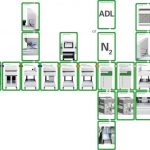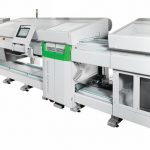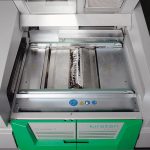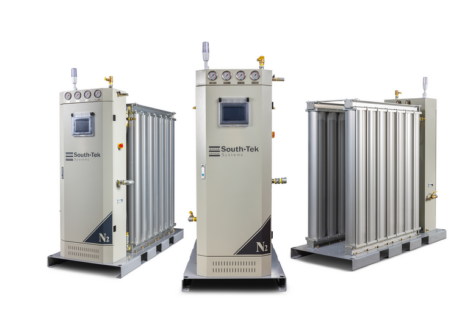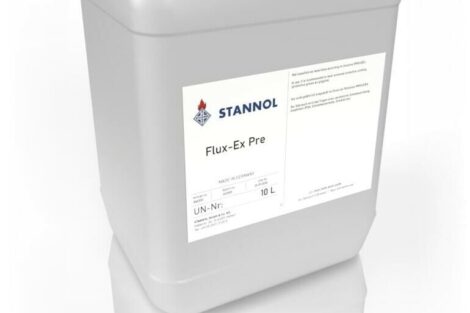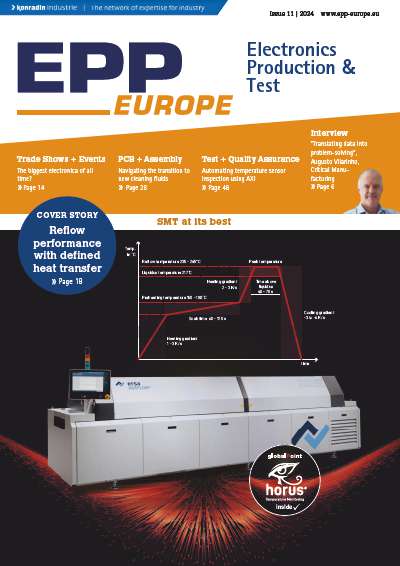Some companies claim that good quality wave soldering is only possible when using a totally enclosed Nitrogen atmosphere in the soldering machine. Pure physics theory would suggest that there might be some advantages but the reality is different.
Kirsten Soldering, Cham (Switzerland)
High pressure liquid Nitrogen is relatively easy to store and it expands into a gas at room temperature and offers a pure, oxygen-free atmosphere for many processes – including wave soldering. There are alternative inert gases such as Argon or Helium but they are either very expensive (Helium) or they do not possess high-enough thermal conductivity (Argon). Theoretically, Hydrogen could be used but it is highly explosive and therefore dangerous. Oxygen is a highly reactive element that rapidly oxides exposed metallised surfaces at soldering temperatures and introducing Nitrogen into the solder atmosphere is a popular method of eliminating oxygen, or at least reducing its volume to negligible proportions. A high purity concentration of Nitrogen (<50 ppm) will also help to eliminate water vapour from the process atmosphere.
Nitrogen is completely inert and does not react with any metallised surface and therefore the exponents of Full Tunnel wave soldering argue that keeping oxygen out of the soldering system in every part of that system is desirable. However, they should also note that oxidation can take place as soon as any metallised surface is exposed to Oxygen (e.g.air). Therefore, ALL components, PCB’s and solders must be manufactured, shipped and stored in a Nitrogen environment. This is prohibitively expensive.
A safe level of purity
Tin (Sn) is found in ALL solder alloys and is a reactive metal. It is the metal used in soldering that is furthest from the noble metals, which are much less reactive, and is therefore able to oxidise rapidly when exposed to even tiny amounts of oxygen. Ideally, a minimum concentration quality of “49.3” (This means 99.99999999999999999999999999999999999999999999999993% pure) is required so that less than one oxygen atom is present in a 50 litre container. This is impossible to achieve with any known technology. Water also reacts with Tin but the reaction is less strong than with Oxygen. However the sources of water or water vapour traces are more common in soldering (e.g. the surfaces and interior of boards and components and fluxes) and it is therefore beneficial to operate a Moisture Reduction programme for components and PCB’s. A full tunnel system will be incapable of eliminating all water vapour from the atmosphere or from aqueous fluxes.
Full Tunnel systems use more flux?
Nitrogen atmospheres are used to reduce the impact of oxidation from oxygen or water vapour in the soldering atmosphere. Theoretically therefore, there should be less chemical activity in a nitrogen atmosphere and there should be less usage of flux. However, the opposite appears to be true based on the experiences of AIM Solders of Canada, one of the world’s largest suppliers of flux. They quote: “When nitrogen, sealed wave solder equipment is used, it is generally necessary to apply slightly more flux than normal as a result of excess drying due to the extended length of the equipment.”
There is therefore no benefit to the user in using a Full Tunnel system. The Nitrogen should used for covering the wave. In the modula wave, nitrogen is used where it is needed, as a cover over the wave to reduce the dross formation and time consumption during maintenance schedules.
ZUSAMMENFASSUNG
Manch Unternehmen glaubt, eine gute Qualität beim Wellenlöten ist nur dann realisierbar, wenn eine geschlossene Stickstoffatmosphäre herrscht. Die Theorie könnte darin einen gewissen Vorteil sehen, jedoch die Realität ist eine andere.
Certaines entreprises considèrent qu’un milieu d’azote clos est indispensable pour obtenir un soudage à la vague de bonne qualité. D’un point de vue théorique, ce procédé peut sembler avantageux, mais la pratique enseigne autre chose.
Share:




